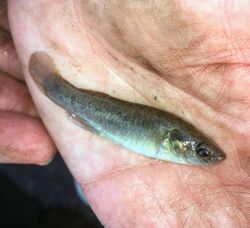Biology:Saltmarsh topminnow
| Saltmarsh topminnow | |
|---|---|

| |
| Scientific classification | |
| Domain: | Eukaryota |
| Kingdom: | Animalia |
| Phylum: | Chordata |
| Class: | Actinopterygii |
| Order: | Cyprinodontiformes |
| Family: | Fundulidae |
| Genus: | Fundulus |
| Species: | F. jenkinsi
|
| Binomial name | |
| Fundulus jenkinsi (Evermann, 1892)
| |
| Synonyms[2] | |
|
Zygonectes jenkinsi Evermann, 1892 | |
The saltmarsh topminnow (Fundulus jenkinsi) is a species of killifish for the family Fundulidae. It occurs in the coastal wetlands of the Gulf of Mexico in the United States.
Description
Saltmarsh topminnows have little color in life; there is cross-hatching on the back and sides that may be gray-green or fainter and 12 to 30 dark round spots are often arranged in rows along the midside of the body from above the pectoral fin to the base of the caudal fin.[citation needed]
Ecology
Saltmarsh topminnows live in estuaries, coastal salt marshes and back water sloughs including shallow tidal meanders of Spartina marshes. They are endemic to brackish water areas from Galveston Bay, Texas to Escambia Bay in the western panhandle of Florida.[citation needed]
Conservation
Habitat alteration, dredging, and marsh erosion are the most serious threats to the saltmarsh topminnow.[citation needed]
Conservation designations
IUCN: Vulnerable.[1]
American Fisheries Society: Threatened in Florida, Vulnerable elsewhere.[citation needed]
Species of Greatest Conservation Need: FL, LA, MS.[citation needed]
Status reviews
In 2006 the Species of Concern Grant program [1] funded the Mississippi Department of Marine Resources for the study: “Fundulus jenkinsi, Saltmarsh Topminnow: Conservation Planning and Implementation”.
Species description and etymology
Fundulus jenkinsi was described in 1892 as Zygonectes jenkinsi by Barton Warren Evermann with the type locality given as Dickinson Bayou, near Galveston, Texas.[3] The specific name honours the United States physiologist Oliver Peebles Jenkins (1850-1935) of Stanford University.[4]
References
- ↑ 1.0 1.1 Collette, B.; Grubbs, D.; Pezold, F.; Simons, J.; Caruso, J.; Carlson, J.; McEachran, J.D.; Brenner, J. et al. (2015). "Fundulus jenkinsi". IUCN Red List of Threatened Species 2015: e.T196678A2473113. doi:10.2305/IUCN.UK.2015-4.RLTS.T196678A2473113.en. https://www.iucnredlist.org/species/196678/2473113. Retrieved 20 November 2021.
- ↑ Froese, Rainer and Pauly, Daniel, eds. (2019). "Fundulus jenkinsi" in FishBase. April 2019 version.
- ↑ Eschmeyer, William N.; Fricke, Ron; van der Laan, Richard, eds. "Zygonectes jenkinsi". California Academy of Sciences. http://researcharchive.calacademy.org/research/ichthyology/catalog/fishcatget.asp?spid=13711.
- ↑ "Order CYPRINODONTIFORMES: Families PANTANODONTIDAE, CYPRINODONTIDAE, PROFUNDULIDAE, GOODEIDAE, FUNDULIDAE and FLUVIPHYLACIDAE". The ETYFish Project Fish Name Etymology Database. Christopher Scharpf and Kenneth J. Lazara. 26 April 2019. http://www.etyfish.org/cyprinodontiformes3/. Retrieved 22 September 2019.
NMFS. Species of Concern Fact Sheet [2]. 2008 Wikidata ☰ Q2972806 entry
 |


